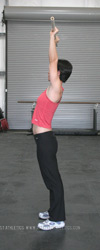The Shoulder - Back Flexibility Connection
Greg Everett | Training: General | May 22 2006
Inflexible shoulder girdles are a commonly overlooked cause of lower back injuries and pain. If the shoulders are unable to open fully (extend the arms vertically), the overhead position is not actually overhead. Therefore, when attempting to lift the arms overhead, the lumbar spine tends to hyperextend, rotating the torso backward to allow the arms attached to the partially opened shoulders to extend vertically. The ability to fully open the shoulder, then, is integral to long-term functionality and injury prevention.
Here are a couple stretches to help improve your shoulder flexibility:
Shoulder Dislocates
Despite the name, this movement should not dislocate your shoulders. Nor should it cause any pain; never force yourself through the ROM. Start with a generously wide grip with which you can easily pass through the full ROM with straight arms. Remain at this width for at least a few passes to warm-up to the movement. Then narrow your grip incrementally as your flexibility allows, always shrugging your shoulders as your arms pass overhead. If using this following training, you may want to pause at the tightest point in the ROM and hold as a static stretch. 10-20 reps.
Kip Swings
Like all dynamic stretches, ease into these and gradually increase the range of motion. 10-20 reps.
Greg Everett | Training: General | May 22 2006
Inflexible shoulder girdles are a commonly overlooked cause of lower back injuries and pain. If the shoulders are unable to open fully (extend the arms vertically), the overhead position is not actually overhead. Therefore, when attempting to lift the arms overhead, the lumbar spine tends to hyperextend, rotating the torso backward to allow the arms attached to the partially opened shoulders to extend vertically. The ability to fully open the shoulder, then, is integral to long-term functionality and injury prevention.
 |
 |
| Proper overhead position with fully open shoulder | Partially open shoulder with lower back hyperextended to compensate |
Shoulder Dislocates
Despite the name, this movement should not dislocate your shoulders. Nor should it cause any pain; never force yourself through the ROM. Start with a generously wide grip with which you can easily pass through the full ROM with straight arms. Remain at this width for at least a few passes to warm-up to the movement. Then narrow your grip incrementally as your flexibility allows, always shrugging your shoulders as your arms pass overhead. If using this following training, you may want to pause at the tightest point in the ROM and hold as a static stretch. 10-20 reps.
Kip Swings
Like all dynamic stretches, ease into these and gradually increase the range of motion. 10-20 reps.
 |
 |
| Shoulder Dislocates | Kip Swings |



Comment